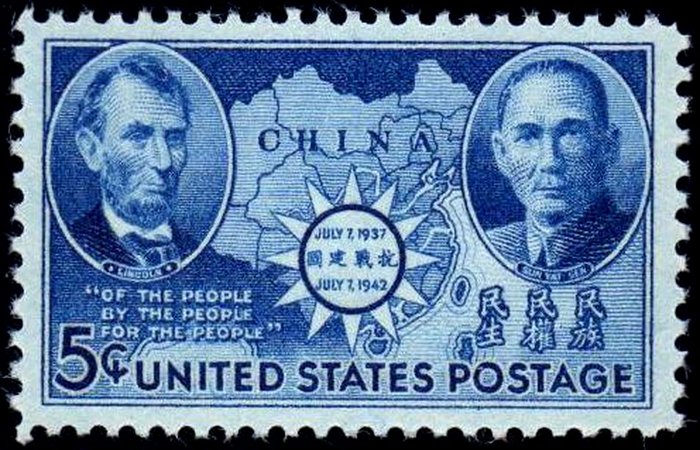By Eric Wu, bostonese.com
As we celebrate the 70th anniversary of the end of WWII this year, many people are wondering when WWII did start? Answers to this question many depend on which ocean you are looking at.

This 1942 USPS stamp commemorates the five-year anniversary of China’s resistance against Japanese invasion(file photo).
According to history.net, the two dates most often mentioned as “the beginning of World War II” are July 7, 1937, when the “Marco Polo Bridge Incident” led to a prolonged war between Japan and China, and September 1, 1939, when Germany invaded Poland, which led Britain and France to declare war on Hitler’s Nazi state in retaliation.
The start of WWII is always under debate. It started in 1937 in Asia, 1939 in Europe, and 1941 in the Pacific. But historians from different countries have not reached an agreement which theater should be recognized as the center of WWII. Since Japan finished its industrialization and developed rapidly in the prewar period, it had considerable military forces which could not be ignored. Therefore, none of the three major theaters can overwhelm the other two in the scales of warfare. Since the war in Asia broke out earlier, the outbreak of the war in Asia is the real start of WWII.
The next question comes up: When did China started the war of resistance against Japan, known as the Second Sino-Japan War? One opinion is that China started the war right after the Marco Polo Bridge Incident in July 7, 1937.[1] And the Republic of China was the first country in the alliance which was later called the Allies. Some other historians, such as Wernar Ghuhl and Norman Polmar, hold that China had already started war against Japan in Manchuria since 1931.[2] It is true that China was at war against Japan for 14 years between 1937 and 1945. There was, however, a transition in 1937. The war in north eastern China, known as Manchuria, was a regional resistance against the Japanese invasion, when there was no national strategy; after the July 7, 1937, Japan expanded its invasion, attempting to occupy the entire East Asia, and China’s war of resistance grew into a total war all over the extensive land of the country. Chiang Kai-shek and his military commission worked out a series of strategic plans and operated several major campaigns. At that moment, the Chinese military forces started to fight the invaders as an entity at the national level. Therefore, the war between 1931 and 1937 can be considered as part of the Second Sino-Japan War, but only the later part of the Sino-Japan War between 1937 and 1945 is part of WWII.
In his 2013 Civil War blog titled “Abraham Lincoln on Stamps – Commemorative Issues, 1909-1958”, Norman Gasbarro worte: “In 1937, the opening shots in what was to become World War II, were fired in China in what was then called the Second Sino-Japanese War. After the five years of struggle of the Chinese people against Japanese aggression, and the entry of the U.S. into what had then become a global conflict, the Post Office issued the third commemorative stamp recognizing Abraham Lincoln – and this time he also shared the design. In keeping with the policy of not depicting living individuals on stamps, the ‘solidarity’ of the U.S. could not be shown with the then Chinese leader Gen. Chiang Kai-shek, but had to be “historical” – the comparison of our own Abraham Lincoln with the founder of the Chinese Republic, Sun Yat-sen.”
So, for people in China and the rest of Asia, WWII started on July 7, 1937, and ended on August 15, 1945. It lasted eight years, one month and eight days.
[1] Forster, Stig, and Myriam Gessler. “The Ultimate Horror: Reflections on Total War and Genocide.” A World at Total War: Global Conflict and the Politics of Destruction 1945 (1937): 53-68. p 64.
[2] Gruhl, Werner. Imperial Japan’s World War Two: 1931-1945. Transaction Publishers, 2010. p 30; Polmar, Norman, and Thomas B. Allen. World war II: America at war, 1941-1945. Random House Inc, 1991.